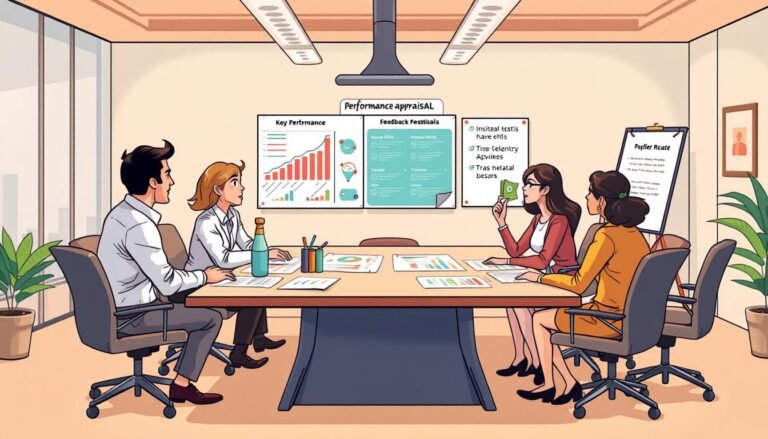How Your Work Environment Shapes Organizational Behavior and Productivity
Ever wondered why some workplaces are full of energy, while others feel slow? The answer is your work environment. It’s not just the physical space. It’s also the invisible forces that shape how we think and act at work.
Your work environment is more than a place to work. It’s where you spend a lot of your life, shaping your career and who you are. Studies show that the workplace reflects and shapes important parts of us. It directly affects how well we do our jobs and our happiness.
In today’s world, people are choosing where they work more carefully. They might work from home, a cafe, a coworking space, or a traditional office. No matter where you work, knowing how your environment affects you is important. It helps create a space that boosts your performance and job happiness.
Let’s explore the interesting world of organizational behavior and company culture. We’ll see how your surroundings can change your work experience. We’ll also learn why smart companies focus on creating the right work environment.
Key Takeaways
- Work environment significantly influences organizational behavior and productivity
- The workplace shapes and reflects important aspects of an employee’s identity
- Employees are making more conscious choices about their work locations
- Understanding the impact of work environment is crucial for optimal workspace design
- Company culture plays a vital role in employee engagement and job satisfaction
- Physical workspace design can significantly affect productivity and well-being
Understanding Organizational Culture and Its Impact
Organizational culture shapes the workplace and affects how employees act. It’s a hidden force that can make or break a company. Let’s look at how culture affects businesses and their people.
Defining Organizational Culture
Organizational culture is the shared values, beliefs, and behaviors that guide employee actions. It shows in how leaders handle crises and teams face challenges. A strong culture matches workplace policies and boosts employee satisfaction.
Positive vs. Negative Work Cultures
Positive cultures help businesses grow and succeed. Companies with healthy cultures see 15% revenue growth over three years. They have supportive leaders and open communication.
Negative cultures, on the other hand, lack support and have poor communication. This leads to low morale and high turnover.
| Positive Culture | Negative Culture |
|---|---|
| 72% higher employee engagement | 38% of employees want to leave |
| 2.5x more likely to see significant stock growth | 85% fail in culture transformation |
The Role of HR in Shaping Culture
HR is key in shaping and keeping organizational culture. They impact recruitment, retention, and employee engagement. Yet, only 31% of HR leaders think their companies have the right culture for future success.
HR must align workplace policies with cultural values to improve employee satisfaction.
“Culture eats strategy for breakfast.” – Peter Drucker
A strong organizational culture is crucial for success. It attracts talent, with 77% of workers considering culture before applying. Companies must focus on creating positive work environments to succeed in today’s competitive world.
The Relationship Between Work Environment and Employee Behavior
Work environments greatly shape how employees behave. A good workplace culture boosts productivity, creativity, and job happiness. It also supports diversity and work-life balance.
Research shows that the quality of work environments affects employee morale and performance. It also impacts their overall well-being.
How Culture Influences Employee Actions
Organizational culture sets the tone for employee behavior. A study by Zeng et al. (2014) found that small and medium-sized enterprises with supportive work environments reported better mental health outcomes among employees. This highlights the strong link between workplace culture and employee well-being.
Positive work cultures encourage innovation and collaboration. Research by Rasool et al. (2019) in China’s banking sector revealed that modern human resource practices fostered organizational innovation. This shows how a supportive environment can drive creative employee behavior.
The Power of Culture Over Rules and Regulations
While rules are important, culture often has a stronger influence on employee actions. A case study by Koser et al. (2018) in Pakistan’s textile sector showed that high-performance work systems accelerated productivity more effectively than strict regulations alone. This underscores the power of a positive work culture in guiding employee behavior.
“A well-developed organizational culture can be more influential than formal rules in shaping employee actions and fostering a diverse, balanced work environment.”
Creating a positive work environment that values diversity and promotes work-life balance is key. It leads to increased engagement, job satisfaction, and productivity. This benefits both employees and organizations.
Work Environment and Employee Engagement
A positive work environment is key to keeping employees engaged. Only 33% of U.S. workers are fully engaged at their jobs. This shows how important it is for companies to focus on their workplace culture.
Companies that support their teams see big boosts in engagement. Important things include:
- Competitive salaries and good benefits
- Flexible schedules for work-life balance
- Regular recognition of employee efforts
- Opportunities for career growth and training
Collaboration in the workplace is also crucial. Activities that bring teams together and a safe space for ideas help. When employees know how their work fits into the company’s goals, they feel more connected.
The office space itself matters too. Ergonomic furniture, good lighting, and facilities like gyms make employees happy. Companies that invest in these areas see better productivity and profits.
“Managers account for 70% of the variance in team engagement.”
By paying attention to these areas, companies can boost employee engagement. This leads to better success and less turnover.
The Impact of Physical Workspace on Productivity
The office space is key to employee productivity. Workers spend a third of their lives at work. A good environment can reduce stress, increase happiness, and spark new ideas.
Office Layout and Design Considerations
Good workplace design means having different areas. There should be quiet spots for focus, team areas for projects, and places to relax. After lockdown, offices are adding cozy touches and natural elements to help people feel calm and well.
Ergonomics and Employee Well-being
Using ergonomic furniture and good lighting is important for comfort and health. Air quality sensors help keep the air clean. These things make a workspace that’s good for your body and mind, helping you work better.
Technology and Tools in the Modern Workplace
Today’s offices use technology to work smarter. Sensors track who’s in the office, helping manage space. Digital signs show who’s where, making things easier. For teams that work from home and office, special video call areas and quiet rooms are needed.
| Workspace Element | Impact on Productivity |
|---|---|
| Natural Elements | Improved air quality, increased calmness |
| Ergonomic Furniture | Enhanced comfort, reduced physical strain |
| Smart Sensors | Better space utilization, reduced stress |
| Collaborative Spaces | Increased innovation, improved teamwork |
By focusing on these design elements, companies can make spaces that help people work better. This leads to happier employees and a successful business.
Company Culture and Job Satisfaction
A positive company culture is key to job happiness and keeping employees. Places that care about their work environment see happier, more productive teams. This link between culture and job satisfaction is crucial today.
Research shows that good cultures lead to better money results. Workers in these places are healthier, happier, and more productive. They also stay longer, saving the company money and keeping things stable.
Having a good work-life balance is also important. Companies that support flexible hours and personal needs keep their employees loyal. A mix of in-office and remote work is now popular, offering both teamwork and flexibility.
To make employees happier, companies can:
- Start regular recognition programs
- Listen to feedback
- Provide chances for growth
- Make sure everyone feels safe
- Support work-life balance
These steps not only make employees happier but also attract the best talent. People looking for jobs often choose companies with good cultures.
| Factor | Impact on Job Satisfaction |
|---|---|
| Positive Culture | Higher engagement, productivity |
| Work-Life Balance | Increased loyalty, reduced burnout |
| Professional Development | Improved retention, career growth |
| Recognition Programs | Enhanced motivation, job satisfaction |
By focusing on these areas, companies can make a place where employees flourish. This leads to better job satisfaction and long-term success.
Fostering Innovation Through Workplace Design
Workplace innovation is key to a company’s success. A creative workspace sparks new ideas and boosts productivity. Let’s see how smart design creates a space for teamwork, risk-taking, and sharing ideas.
Creating Spaces for Creativity and Collaboration
Modern offices are changing to support innovation. Meeting rooms have floor-to-ceiling whiteboard walls for quick idea sharing. Open layouts encourage spontaneous talks, while quiet areas help with focused work.
This variety of spaces supports different work styles and boosts creativity.
Encouraging Risk-Taking and Idea Sharing
A workplace that values innovation does more than just design. Companies can build a creative culture through:
- Weekly brainstorming sessions
- Problem-solving competitions
- Flexible work schedules
- Training on creativity and teamwork
These steps help employees think differently and share their ideas openly.
Studies highlight the importance of these efforts. McKinsey found that 94% of top executives see people and culture as innovation’s main drivers. By fostering a collaborative space for creativity, companies can enhance their innovative edge and stay competitive.
Work Environment and Communication Patterns
The work environment greatly affects how we communicate at work. A culture that encourages open dialogue helps share ideas clearly and honestly. This leads to better teamwork and decision-making.
Studies show how good communication can make a company succeed. Yet, only 13% of employees think their leaders communicate well. This shows we need to work on our communication strategies at work.
- Direct: Fact-based, struggles with small talk
- Functional: Process-oriented, detail-focused
- Collaborative: People-centric, values cooperation
- Influencer: Prioritizes emotional connections
Knowing these communication styles helps leaders adjust their approach. Tools like DiSC Profile help find out how we like to communicate.
Companies that listen to their employees do better. For example, Exemplis uses newsletters with surveys to keep staff involved and get feedback. This way, they encourage open dialogue and improve communication at work.
| Communication Factor | Importance |
|---|---|
| Easy co-worker communication | 13.9% |
| Clear responsibilities | 13.7% |
To make communication better at work, focus on clear leadership, regular talks, and anonymous feedback tools. These steps make sure everyone feels heard and valued.
The Role of Leadership in Shaping Organizational Behavior
Leadership is key in shaping how a company works. Good leaders set the company’s values and guide what employees do. This goes beyond just making rules, affecting the culture and how well things get done.
Leading by Example
Leaders who live by the company’s values inspire their teams. When leaders show integrity, innovation, and teamwork, their teams are more likely to do the same. This makes the workplace a united and productive place.
Implementing and Reinforcing Cultural Values
Great leaders don’t just talk about values; they live them every day. They praise actions that match the company’s culture. This makes those values a part of the company’s identity.
| Leadership Action | Impact on Organizational Behavior |
|---|---|
| Consistent communication of values | Increased employee understanding and adoption of values |
| Recognition of value-aligned behaviors | Reinforcement of desired workplace behavior |
| Transparent decision-making | Enhanced trust and employee engagement |
Addressing Toxic Behaviors and Promoting Positive Change
Good leaders quickly deal with bad behaviors that harm the workplace. They have fair ways to manage performance and help people get better. This creates a positive work environment, boosting engagement and reducing burnout.
“A leader is one who knows the way, goes the way, and shows the way.” – John C. Maxwell
Companies with strong leadership have 72% more engaged employees. This shows how important leadership is in creating a successful and happy workplace.
Conclusion
The impact of the work environment on success and well-being is huge. A positive culture, good office design, and strong leadership are key. They shape how teams work and make them more productive.
Companies that focus on these areas see happier, more engaged employees. This leads to better results for everyone.
Nowadays, employees want more from their workplaces. They want choices, mobility, privacy, and to feel well. The idea of the 20-minute city and offices with nature show this shift.
These changes are not just nice-to-haves. They’re crucial for keeping the best people. They help attract and keep top talent.
Looking to the future, companies need to treat all employees equally, no matter where they work. This fair approach, along with caring for employee well-being, is vital. It will help businesses succeed.
By listening to and meeting employee needs, companies can grow. They can become more innovative, productive, and have a strong, happy team.
Source Links
- Impact of Employees’ Workplace Environment on Employees’ Performance: A Multi-Mediation Model
- How Organizational Culture Influences Employee Behavior | Together Mentoring Software
- Organizational Culture: Definition, Importance, and Development
- Understanding Organisational Culture and its Impact on Workplace Relationships
- How Toxic Workplace Environment Effects the Employee Engagement: The Mediating Role of Organizational Support and Employee Wellbeing
- Work Environment: What it is, Types & Elements to Create it
- The Importance of Workplace Environment in Employee Engagement
- How to Improve Employee Engagement in the Workplace
- How the Physical Workspace Impacts the Employee Experience – Freespace
- How the physical workspace impacts the employee experience / productivity | Onyx Health
- Why Workplace Culture Matters – Professional & Executive Development | Harvard DCE
- How Does Company Culture Impact Employees?
- How to Foster Innovation in the Workplace | HBS Online
- How good workplace design can foster creativity
- 5 can’t-miss keys to fostering innovation in the workplace
- Workplace Culture and Communication: How One Affects the Other
- Is Your Workplace Communication Style As Effective As It Could Be? – Professional & Executive Development | Harvard DCE
- The Role of Leadership in Shaping Organizational Behaviour
- The Role Of Leadership In Shaping Organizational Culture
- The Role of Leadership in Shaping Organizational Culture
- Conclusions and Recommendations – Health and Safety Needs of Older Workers
- The office talks: conclusion | 10 |
- Conclusions







